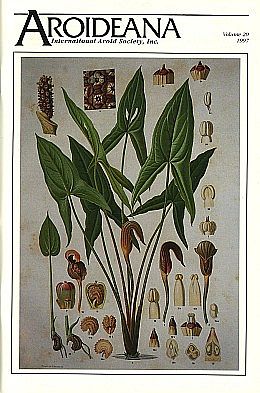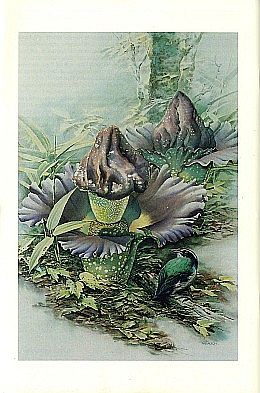|
|



Your search for articles published in volume 20 has found 15 articles.

| 
|
Articles of 3 pages or less are available for free to IAS members for download, and longer articles for $5. Articles from issues in 2016 and beyond are only available electronically, and are free to current members when they are logged in.
Please remember that all Aroideana articles are protected by copyright, and you may NOT distribute even electronic copies without permission from the authors or editor.
(Issue) |
||||
| Peter Mayotte | In Memoriam--Robert L. “Bob†See
This article available FREE to IAS Members with a PERSONAL login. LOGIN, REGISTER or JOIN | |||
| ABSTRACT: We regret to announce the death of Robert L. "Bob" See, Jr. of Coconut Grove (Miami) , Florida. b. 17 May 1922 d. 2 April 1997 | ||||
| Josef Bogner | The pollen of Chlorospatha longipoda (K. Krause) Madison (Buy) | |||
| ABSTRACT: During routine studies of pollen grains, we came across a peculiarity of pollen formation in Chlorospatha longipoda. Most aroids shed the pollen grains in monads; only two genera, Xanthosoma and Chlorospatha, shed their pollen grains in tetrads. Usually the four pollen grains in a tetrad are arranged tetrahedrally, but Chlorospatha longipoda also has linear tetrads in which the four pollen grains are arranged in a serial sequence. | ||||
| Dilip De Sarker, Wilbert L. A. Hetterscheid | Notes on Amorphophallus (Araceae)
This article available FREE to IAS Members with a PERSONAL login. LOGIN, REGISTER or JOIN | |||
| ABSTRACT: A recent collection of Amorphophallus margaritiferand its subsequent cultivation (Hetterscheid & De Sarker, 1996) made it possible to study some cytological details of this remarkable species. The species is widely known as Ptesmonium margaritij er (Roxb.) Schott but has been reclassified in Amorphophallus sect. Rhaphiophallus (Bogner et at., 1985; Hetterscheid et al., 1994). The present short communication reports the chromosome number of A. margaritifer and a comparison is made to other species of A. sect. Rhaphiophallus. | ||||
| Julius O. Boos | Observations on New World Araceae--Lasieae (Buy) | |||
| ABSTRACT: Three neotropical Lasioids were cultivated and studied over a period of years. Observations were made which add to our knowledge of these poorly studied plants, some previously known only from a few herbarium specimens. Further research is urgently needed both in the lab and field as continuing deforestation seriously threatens the survival of several species in the wild. In addition, the culture of these semi-aquatic plants has proven difficult, and their survival in most collections is normally very short term. Methods for their successful cultivation have been outlined (Boos, 1993) and research continues to improve their long term survival. The genus Urospatba is in urgent need of revision. Two of the three described species of Anapbyllopsis are known only from a Single herbarium sheet. | ||||
| Josef Bogner | Book Review
This article available FREE to IAS Members with a PERSONAL login. LOGIN, REGISTER or JOIN | |||
| ABSTRACT: Die Samen der Araceen, E. Seubert, 1993.433 pages with many line drawings. | ||||
| Adelheid R. Kuehnle | Progress in protoplast Isolation and culture from axenic tissues of hybrid Anthurium (Buy) | |||
| ABSTRACT: Protoplasts capable of first divisions were isolated from Anthurium andraeanum Linden ex Andre hybrids using axenic etiolated shoots of the University of Hawaii Antburium cultivars 'Rudolph', UH1060, and UH1003. Enzymatic digestion by 1.5% (w/v) Cellulase R-lO, 0.5% Macerozyme R-10 and 0.5% Driselase in 0.5 M mannitol gave consistent yields between 1.6 X 104 to 2.2 X 104 protoplasts per gram fresh weight of etiolated shoots. In contrast, similar digestions using green leaves of micropropagated plantlets always resulted in mixtures of protoplasts and partially digested cells in ratios of about 1:1 to 1:3, respectively, with a mean yield of 3.8 X 105 protoplasts per gram fresh weight of leaves. Etiolated shoots exposed to a 14-day low light treatment gave consistently higher yields than those with no light exposure, with 3.8 X 104 and 1.8 X 104 protoplasts per gram fresh weight, respectively. Anthurium 'Rudolph' and UH1060 protoplasts were cultured in darkness at densities ranging from 2.5 X 104 to 7.0 X 104 protoplasts ml- ' in a basic tobacco protoplast culture medium with 1 mg' liter-l 6-benzylaminopurine, 1 mg·liter-' IX-naphthaleneacetic acid, and 0.1 mg·liter-' 2,4-dichlorophenoxyacetic acid either in liquid or embedded in 0.6% agarose. Antburium etiolated shoot protoplasts divided within 2 to 6 days and some sustained divisions to form microcolonies within 10 days under these conditions. | ||||
| Gregori G. Hambali, Mary Sizemore | The rediscovery of Lasia concinna Alderw. (Araceae: Lasioideae) in West Kalimantan
This article available FREE to IAS Members with a PERSONAL login. LOGIN, REGISTER or JOIN | |||
| ABSTRACT: In March 1996, the authors, accompanied by John Banta and Tan Jiew Hoe, lAS members, undertook a trip to botanically interesting areas of West Kalimantan. On March 27, the group succeeded in finding the much sought-after plant in the southwestern part of Bukit Kelam, near Sin tang. | ||||
| Josef Bogner | History of Araceae (Buy) | |||
| ABSTRACT: A historic look at the study of Araceae from ancient times to the present is presented. | ||||
| Van Du Nguyen, Thomas B. Croat | A new species of Typhonium (Araceae) from Vietnam (Buy) | |||
| ABSTRACT: The paper describes a single new species of Typhonium, T. buense Nguyen Van Dzu & Croat. It is believed to be endemic to Vietnam. The principle author, Nguyen Van Dzu, has been engaged in studies of the Araceae of Vietnam for several years; he conducted field work with the second author in Vietnam in 1995. A recent collection of Typhonium made by the principle author has proven to be new to science. | ||||
| Shrirang R. Yadav, K. S. Patil, M. K. Janarthanam | A new species of Arisaema (Araceae) from western Ghats of southern India (Buy) | |||
| ABSTRACT: Our intensive survey of aroids of Western Ghats in the States of Maharashtra, Karnataka, and Goa for the last 10 years has resulted in the discovery of three new species of aroids. Of the three species, Arisaema sabyadrica Yadav, Pati!, and Bachulkar [Willdenowia 23:177-179, 1993.1 and Amorpbopballus konkanensis Hetterscheid, Yadav & Pati! [Blumea 39:289-294, 1994.1 have already been described, and one more new species of Arisaema is described here. Arisaema sivadasanii Yadav, Patil & Janarthanam sp. nov. | ||||
| Wilbert L. A. Hetterscheid, Mary Sizemore | Aroid profile: Filarum manserichensis Nicols. (Araceae)
This article available FREE to IAS Members with a PERSONAL login. LOGIN, REGISTER or JOIN | |||
| ABSTRACT: This paper presents an amended description of F manserichensis based on Nicolson's description and the new flowering material. For the first time photos of living plants of Fi/arum are published. See Figs. 1-3. | ||||
| Guy Gusman | Arisaema lobatum Engl. (Araceae) and its taxonomic position (Buy) | |||
| ABSTRACT: Arisaema lobatum Engl. differs markedly from other species of the section Pedatisecta by stable morphological characters. This indicates that A. lobatum occupies a special position in the section and leads to the creation of the new subsection Lobata. | ||||
| Dorothy E. Shaw, L. H. Bird, L. I. Forsberg | Gynmostachys anceps R. Br.: Australian range and habitat in southeastern Queensland (Buy) | |||
| ABSTRACT: The range of G. anceps in Australia is depicted together with the results of two detailed surveys in southeastern Queensland and at other specific sites. Although occurring in a variety of situations, the plant was most prevalent in open (wet sclerophyll, Eucalyptus, hardwood) forest where flowering and fruiting were also more abundant than in closed (vineforests, rainforest) forest. | ||||
| Dorothy E. Shaw | Gynmostachys anceps R. Br.: Fruit (Buy) | |||
| ABSTRACT: Fruit of G. anceps is described, including the presence of a cavity at the apex of the endosperm. Germination occurred without dormancy in 34-40 days, with seedlings producing cataphylls before the first foliar leaf. Roots of seedlings were plump, lacked root hairs, were sparsely branched, and had proximal transverse wrinkles indicative of contractile roots. Possible means of dispersal are discussed, but observations support the contention that the fruit is passively dispersed, i.e. after abscission it falls to the ground around the mother plant and germinates among or under leaf litter and other debris. | ||||
| M. Sivadasan, M. Wilson | Morphology and floral vasculature of Theriophonum infaustum N. E. Br. (Araceae) (Buy) | |||
| ABSTRACT: Theriophonum infaustum N.E. Br. (Araceae) is monoecious with unisexual flowers. The female flowers are with unilocular ovaries having basal and apical suborthotropous ovules. The present study of the floral vascular organization revealed that the ovary is tricarpellate syncarpous, but unilocular and hence pseudomonomerous. The basal and apical placentae are truly basal-parietal and apical-parietal, and they originated by the elimination of septa and ovules along the central region. Vascular organization in the female flowers was found to be diverse, having fused and independent lateral bundles of corresponding carpels of the tricarpellate syncarpous unilocular gynoecium. The male flowers were supplied with single unbranched staminal bundles and this is a derived condition from the primitive multiple- traced condition. The neuter flowers were also supplied with single bundles resembling that of staminal bundles. The sterile spadix appendix was presumed to have formed by the fusion of aborted staminate flowers as evidenced by the lateral bundles produced at the lower half of the appendix. | ||||
All Images and Text © 1996 to 2024 by the International Aroid Society or by their respective owners as noted.
Please send your comments to
served by aws-web2
